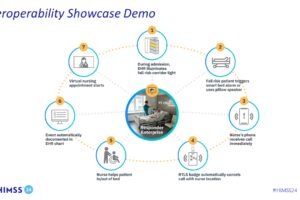According to Alzheimer’s Disease International (ADI), someone in the world develops dementia every 3 seconds. An estimated 50 million people had dementia in 2017. That number is expected to grow to 75 million people by 2030.
 In 2017, Dr. Anitha Rao, a board certified geriatric neurologist and CEO of Neurocern, published a paper that highlighted the uneven distribution of trained dementia specialists in the United States. Her paper pointed to 20 States that were “Dementia Deserts” where there was insufficient access to specialists given the number of Dementia patients. Without intervention, this gap in Dementia care will only get wider.
In 2017, Dr. Anitha Rao, a board certified geriatric neurologist and CEO of Neurocern, published a paper that highlighted the uneven distribution of trained dementia specialists in the United States. Her paper pointed to 20 States that were “Dementia Deserts” where there was insufficient access to specialists given the number of Dementia patients. Without intervention, this gap in Dementia care will only get wider.
While practicing at UCSF’s renowned Memory & Aging Center, Rao noticed two alarming trends:
- The time between booking an appointment and the actual appointment continued to grow
- More and more undiagnosed patients were coming in to the Center
ADI estimates that only 20-50% of dementia cases are recognized and documented in primary care. With little training and few resources available to patients, primary care doctors are reticent to tell patients they may have Dementia. Read this excellent, and frightening, article by Alice Park in Time on this topic.
An unfortunate consequence of this delay in diagnosis, was that Rao often had the unenviable job of telling patients and their families that the disease had progressed beyond the early-stage interventions that might have made a difference. Worse, she found that many patients were taking medications that were ineffective or harmful given their particular type of Dementia (there are many types of Dementia including Alzheimer’s, Lewy Bodies, Vascular, Frontotemporal, etc).
It was around this time that Rao came across two siloed data sets. One was the distribution of neurologists by state. The other was a data set of Dementia patients by state by year (including future years). She mashed the data together and what resulted was an eye-opening map of Dementia Deserts. The state of Wyoming, for example, was particularly ill-prepared to handle the expected number of Dementia patients. With very few Dementia specialists practicing in the state, patients residing there would likely have poorer outcomes due to lack of access. Rao’s paper has since been used by state agencies to lobby for more training and funding for neurological resources.
Rao, however, didn’t stop at simply identifying the problem. She wanted to do something about it and Neurocern was the result. After analyzing the problem she zeroed in on two specific issues: access to care and the lack of expert Dementia advice for patients. Here’s how the system works:
- Patients and/or family build a brain profile in the application by answering questions (think a Myers-Briggs assessment but for your brain)
- Based on the brain profile, the system comes up with recommendations for what can be done at home to keep seniors safe
- Recommendations include:
- How to gently convince someone to wash themselves (patients suffering from Dementia usually refuse to bathe)
- How to help patients not to slip in the bathroom
- The signs to look for if the patient needs insulin. Some Dementia patients pace the room which means they burn their sugar faster than normal and if they also have Diabetes they will need insulin sooner

“Neurocern is a cross between a neurologist and a social worker,” explains Rao. “It mirrors how my sessions with patients would go. For the first hour I would sit and listen to the family’s story. I’d use that information to build a profile. In the second hour I would review a care plan with the patient and their family. I would make sure they had things they could do at home to help reduce the impact of the Dementia. For example, if a patient suffers from, hallucinations, one of the care recommendations would be to cover mirrors in the home as they are triggers for hallucinations.”
Neurocern currently is capable of generating 5,000,000 care plans based on individual attributes discerned from the brain profile. Plans can be customized by the end-user.
The application has been piloted by a provider organization and Rao is currently in pilot discussions with a number of payers. “There is definitely a financial incentive to help patients better manage Dementia,” says Rao. “Dementia patients are 20% more likely to be readmitted and they have longer than average length of stays (ALOS). Dementia patients who have suffered a stroke have, on average, 38% higher costs. It’s the same story with Dementia + diabetes or other chronic conditions. On top of this is the fact that many healthcare organizations do not have the Dementia-trained staff to care for these patients. Neurocern can help to bridge that gap.”
Dementia is quickly becoming the leading cause of death around the world. It is already #1 in England and Wales and is the top cause of death for Australian women. In many other countries Dementia trails only heart disease. Without adequate training, resources and funding, our healthcare system runs the risk of being overwhelmed. We will need products like Neurocern and people like Rao to ensure the problem gets attention and that patients as well as providers have tools at their fingertips to help mitigate Dementia’s impact.
Rao will be presenting on a panel at next week’s AHIP conference – Innovate with Purpose: Technology Tools of Change alongside 3 other healthcare entrepreneurs.














Units of currency used to bet with in slot games.
Hellboy is a daring, dark and racy online slots game.